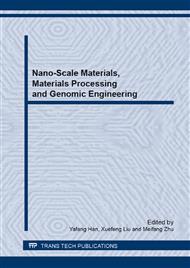p.282
p.290
p.297
p.303
p.308
p.314
p.320
p.328
p.336
Effect of Deformation Ratio on Microstructures and Properties of High Nitrogen Martensitic Stainless Steel
Abstract:
To reveal the effect of deformation ratio on high nitrogen martensitic stainless steel, the room temperature mechanical properties, microstructures and precipitates morphology were studied by using optical microscope (OM), scanning electron microscope (SEM) and transmission electron microscope (TEM) as well as mechanical tests. The results indicate that the tensile strength, yield strength and impact energy were raised 241MPa, 180MPa and 10.0J respectively, at a higher deformation ratio. While, the average original austenite grain size was refined from 14.93μm to 9.57μm when the deformation ratio was increased from 0.65 to 0.83 as well as the martensite lath width thinned from 400nm to 250nm. Furthermore, at various deformation ratios, the precipitates morphology was different in quantity, grain size and dispersion. There are more eutectic precipitates and secondary precipitates dispersed along the grain boundary as continuous chains with lower deformation ratio. On the contrary, the precipitates in specimen with higher deformation ratio were uniform and fine without chain or network. It can be inferred that the improvements on mechanical properties, microstructures and precipitates morphology are mainly due to the deformation ratio.
Info:
Periodical:
Pages:
308-313
Citation:
Online since:
April 2014
Authors:
Price:
Сopyright:
© 2014 Trans Tech Publications Ltd. All Rights Reserved
Share:
Citation:


